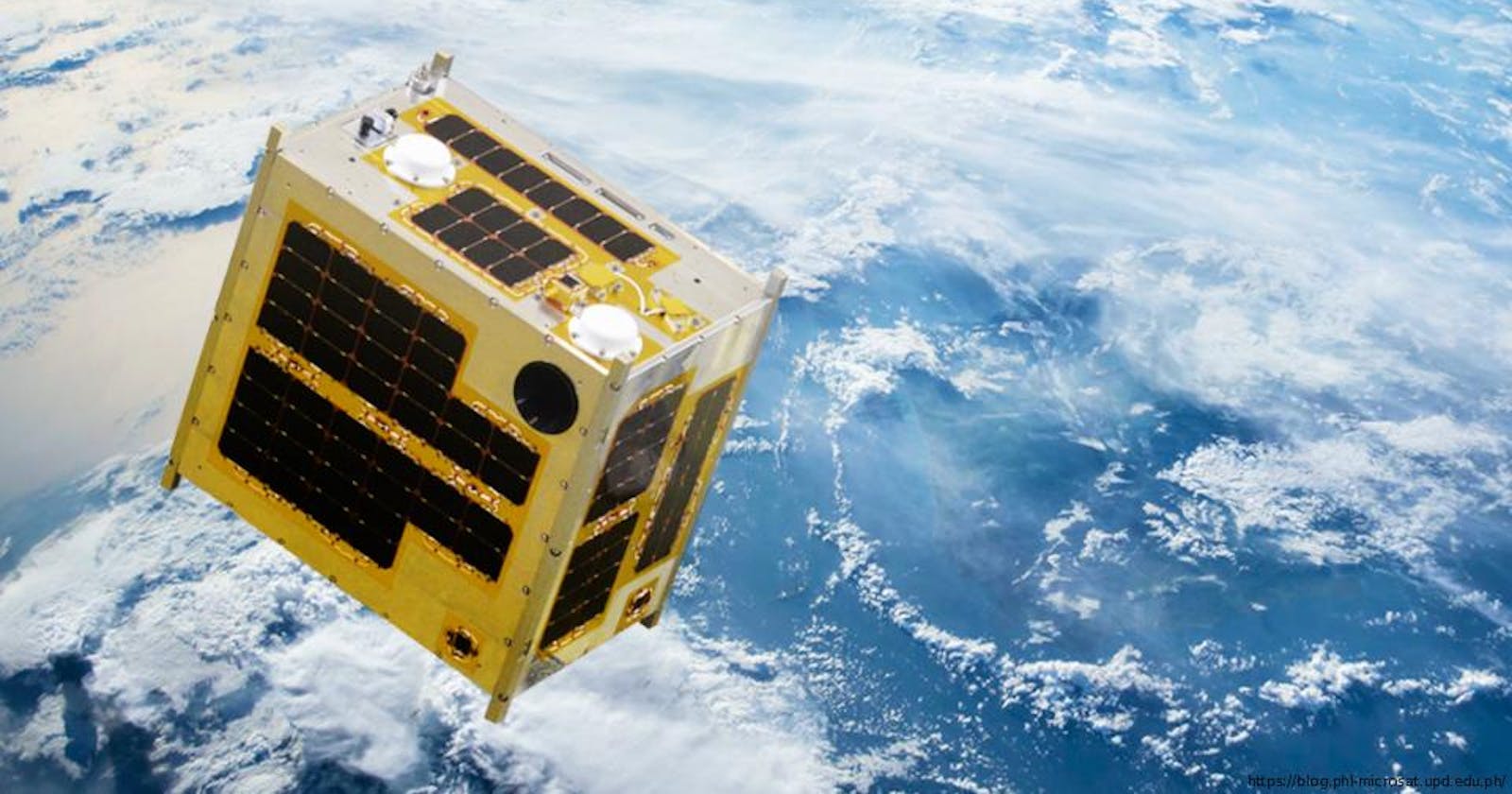မြန်မာနိုင်ငံလေကြောင်းနှင့် အာကာသပညာတက္ကသိုလ် (MAEU) နဲ့ ဂျပန်နိုင်ငံ ဟော့ကိုင်းဒိုး တက္ကသိုလ်တို့ ကနေပြီး အသေးစားဂြိုလ်တု တစ်လုံး ဆောက်နေတဲ့ သတင်းကိုအရင်က ဖတ်ဖူးတယ်။ အသေးစိတ်တော့ မသိခဲ့ဘူး။ အခု ဒီဂြိုလ်တုကို ဂျပန်ကပဲ ဆက်ထိန်းသိမ်းထားဦးမယ်ဆိုတဲ့ statement တစ်စောင်ကို ဖတ်မိတော့မှ လိုက်ရှာဖတ်ကြည့်မိတယ်။
သိရသလောက်တော့ ဂျပန် ယန်း ၁၆၈၀ မီလီယံ တန်ဖိုးရှိတဲ့ ၅ နှစ် သဘောတူညီချက် ရှိထားတယ်။ 1 September 2019 ကနေ 31 August 2024 အထိ ကြာမယ်။ ကီလို ၅၀ တန်း အသေးစားဂြိုလ်တု ၂ လုံးပါမယ်။ မြေပြင်စခန်းငယ် တစ်ခု ရယ် သုတေသန စမ်းသပ်ခန်းတစ်ခုရယ် နည်းပညာဆိုင်ရာ လွှဲပြောင်းပေးဖို့ ၁၄ ယောက်ကို သင်တန်းပေးဖို့ရယ်၊ အခြား ပညာရှင် ၇ ယောက်ကို လုပ်ငန်းခွင်သင်တန်းပေးဖို့ အစီအစဉ်တွေ ပါဝင်တယ်လို့ သိရတယ်။ လောကနတ်-၁ ကို 2021 ဖေဖော်ဝါရီလ ထဲမှာ နိုင်ငံတကာ အာကာသစခန်းဆီကို လွှင့်တင်သွားဖို့နဲ့ 2021 မတ်လ ထဲမှာ ကမ္ဘာပတ် လမ်းကြောင်းထဲကို ပို့ဖို့ စီစဉ်ထားတယ်။ (အစီအစဉ်အတိုင်း လုပ်နိုင်နေတာကိုတွေ့ရတယ်) နောက်တစ်လုံးဖြစ်တဲ့ လောကနတ်-၂ ကိုတော့ 2023 ခုနစ် စက်တင်ဘာလ ထဲမှာ ထပ်ပြီး လွှင့်တင်သွားမယ့် အစီအစဉ် ရှိတယ်တဲ့။
အာဏာသိမ်းမှု ဖြစ်သွားတာနဲ့ မြန်မာပြည်သူတွေလည်း အာရုံ မစိုက်နိုင်ကြဘူးထင်ပါတယ်။ မြန်မာလူမျိုး မမီမီအောင် ပါဝင် ပတ်သတ်တဲ့ NASA ရဲ့ Perseverance ယဉ် အင်္ဂါဂြိုလ်အပေါ်ကို ဆင်းသက်နေတဲ့အချိန် ကိုယ့်မြန်မာနိုင်ငံမှာတော့ အင်တာနက်တွေ အဖြတ်ခံထားရတယ်လေ။ အခုလည်း စစ်ဘက်ဆိုင်ရာ အသုံးပြုလာနိုင်မှုတွေကို စိုးရိမ်တဲ့အတွက် မြန်မာနိုင်ငံဘက်ကို ချက်ချင်း လွှဲမပေးသေးပဲ ဂျပန် ပညာရှင်တွေကပဲ ဆက်ပြီး ထိန်းသိမ်းပေးသွားမယ်လို့ ကြေငြာချက်ထဲမှာ ဖတ်ရတယ်။ ဝမ်းနည်းစရာတော့ ကောင်းပေမယ့် တော်ပါသေးတယ်လို့ပဲ ပြောရမယ်ထင်တယ်။ မဟုတ်ရင် အာဏာရူးကောင်တွေက ဂြိုလ်တုကို စစ်ဘက်ဆိုင်ရာအတွက် ဓာတ်ပုံတွေကို အသုံးပြုနေရင် စိုးရိမ်စရာကောင်းမှာ။ အာဏာသိမ်းပြီးတဲ့နောက် MAEU ရဲ့ ပါမောက္ခချုပ် ဒေါက်တာကြည်သွင် နဲ့လည်း အဆက်အသွယ် မရတော့ကြောင်း RFA ရဲ့ သတင်း တစ်ပုဒ်မှာလည်း ဖတ်ရပါတယ်။
အခုတော့ ဒီ အသေးစား ဂြိုလ်တုဟာ နိုင်ငံတကာ အာကာသ စခန်းကနေပြီး Low Earth Orbit လို့ခေါ်တဲ့ ကမ္ဘာ့ အနိမ့်ပတ်လမ်းကြောင်းထဲကို လွှတ်နိုင်ခဲ့ပြီတဲ့။ ကီလို ၅၀ လောက်ပဲ အလေးချိန်ရှိတာဆိုတော့ အသေးလေးပါ။ ပုံအချို့ ကတော့ ဖိလစ်ပိုင်အသေးစား ဂြိုလ်တု DIWATA-2 ရဲ့ ပုံတွေဖြစ်ပါတယ်။ မြန်မာဂြိုလ်တုကလည်း သူတို့ကပဲ တည်ဆောက်ပေးပြီး အဲ့ဒီ ဒီဇိုင်းပဲလို့ ယူဆရပါတယ်။ ကြေငြာချက် အပြည့်အစုံကို မြန်မာဘာသာနဲ့ရော အင်္ဂလိပ်ဘာသာနဲ့ပါ အောက်မှာ ထည့်ထားပေးပါတယ်။ References: နေရာမှာလည်း pdf ကို download ယူနိုင်ပါတယ်။

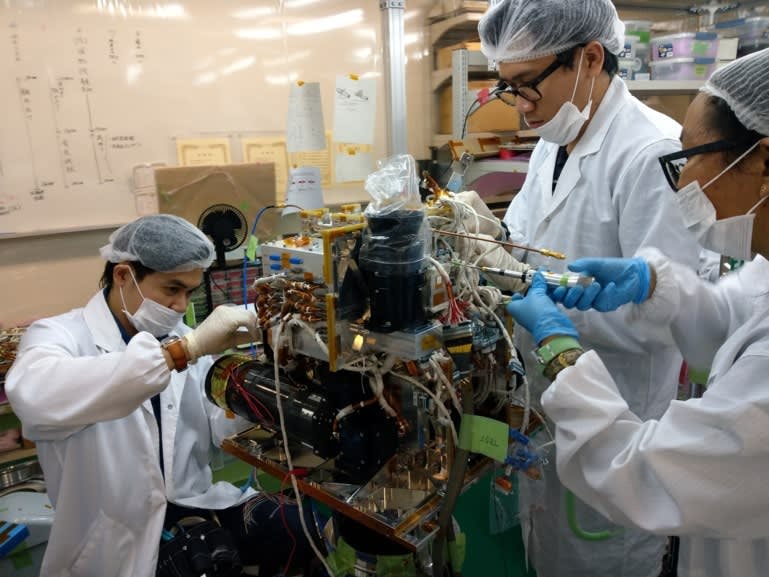
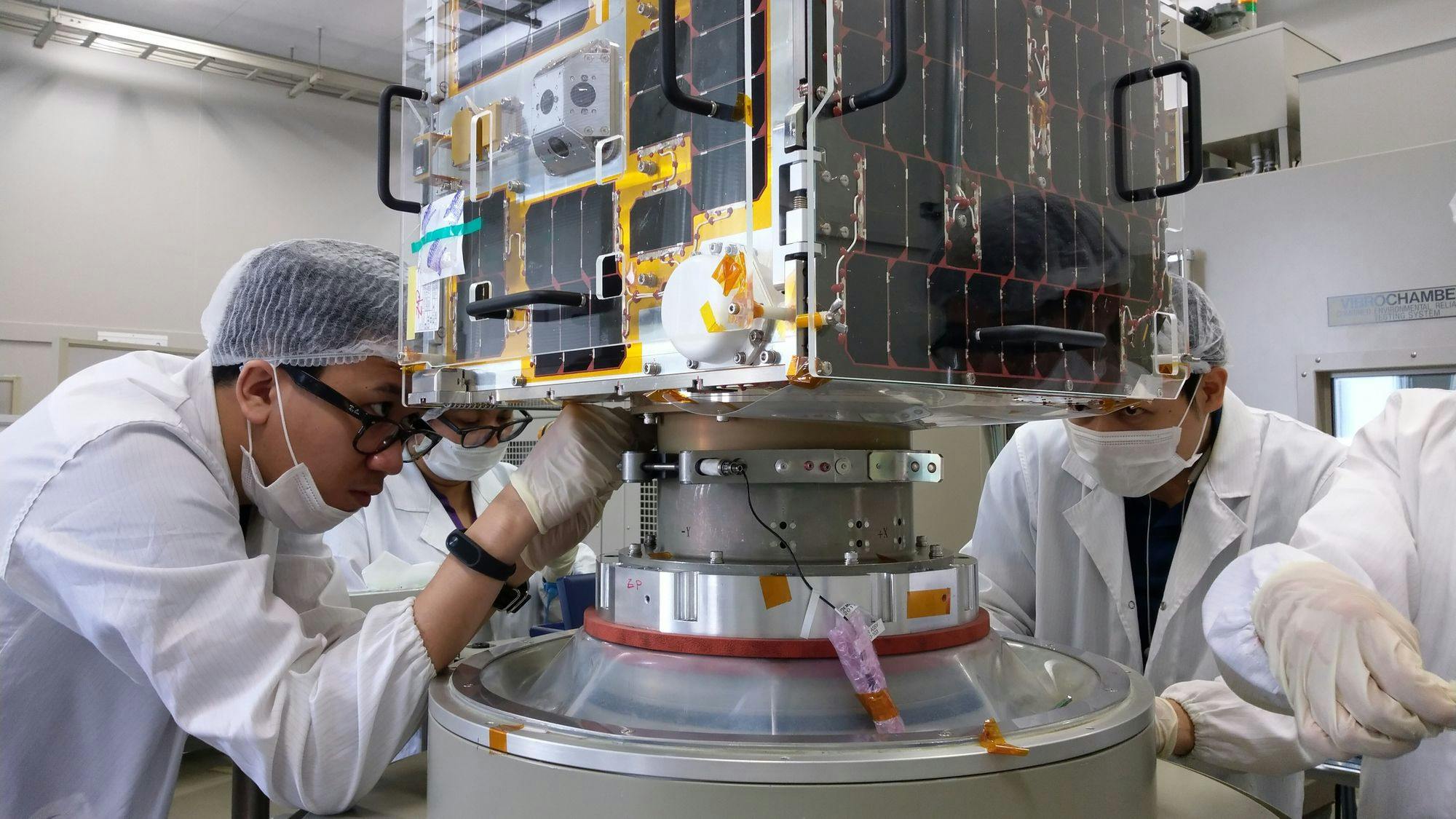

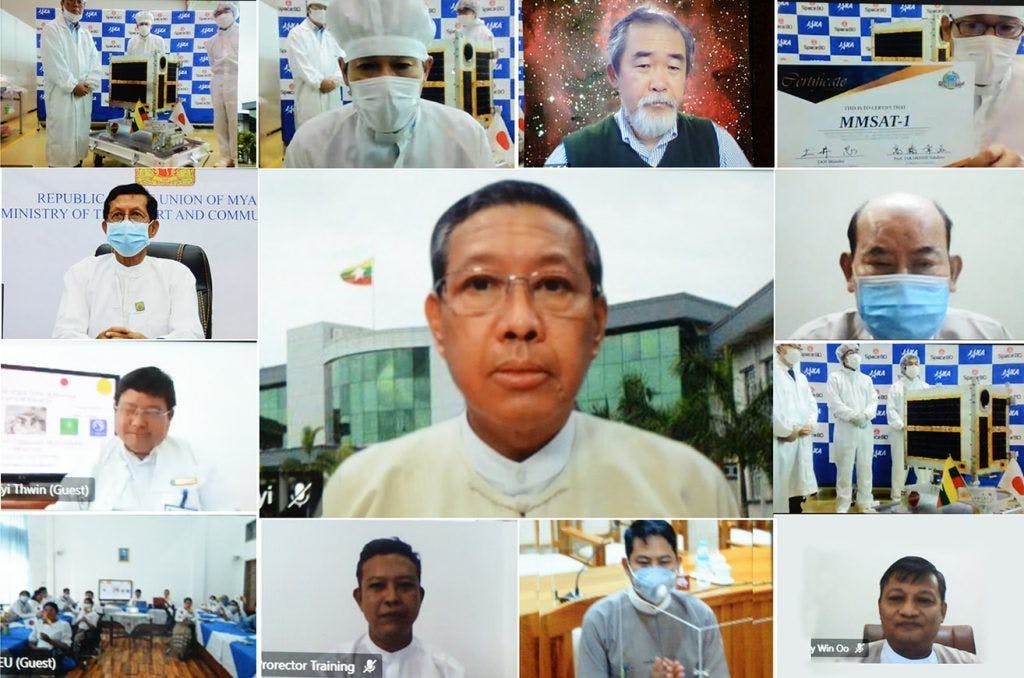
အချို့ပုံများမှာ လောကနတ်-၁ နှင့် ပုံစံတူသော ဖိလစ်ပိုင်နိုင်ငံပိုင် အသေးစား ဂြိုလ်တု Diwata-2 ၏ပုံများဖြစ်ပါသည်
ဒီအကြောင်းကို ကျွန်တော့ twitter မှာ tweet ပြီးတဲ့နောက် ISS ရဲ့ live ကိုကြည့်နေတဲ့ ဝါဿနာရှင်တ စ်ချို့က ဘယ်သူ့ရဲ့ microsat လွှင့်လိုက်မှန်းမသိကြပဲ အဖြေရှာနေကြတာနဲ့ ကြုံကြိုက်သွားတယ်နဲ့ တူပါတယ် ကိုယ့် tweets ကို မြင်သွားကြတယ်။ အောက်ကပြထားတဲ့ tweet မှာတော့ live ထဲကနေ လောကနတ်-၁ ကို ထုတ်လွှတ်လိုက်တဲ့ အခြေအနေကို Screenshot ရိုက်ထားခြင်းဖြစ်ပါတယ်။
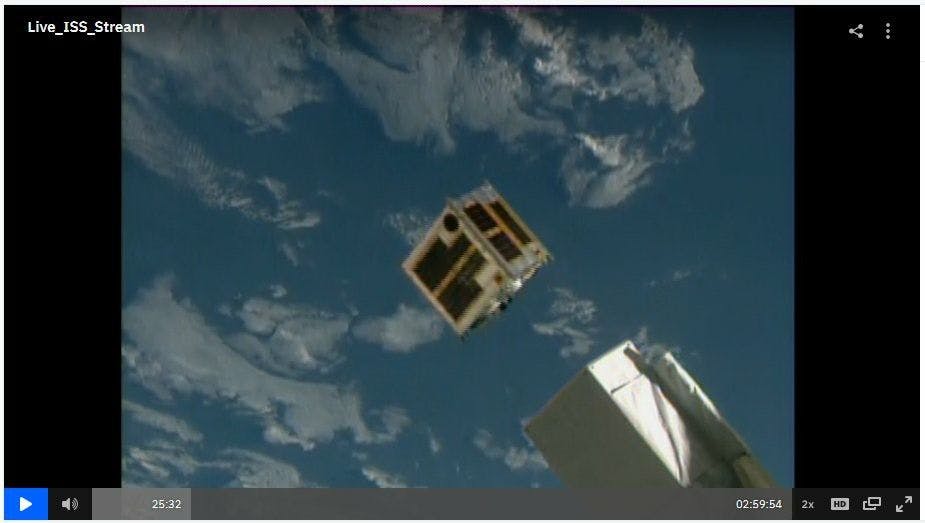
ISS မှာ ရှိတဲ့ Kibo Module ကနေ J-SSOD-M2 deployer နဲ့ လောကနတ်-၁ ကို ထုတ်လွှတ်စဉ်။ မြန်မာစံတော်ချိန် ညနေ ၃ နာရီ ၂၂ ရက် မတ်လ။ ဓာတ်ပုံ - @anik1982space
လောကနတ်-၁ ရဲ့ ပုံ အစစ်ပါ။ ကိုယ်တွေဆီက တရားဝင် သတင်းထုတ်ပြန်ချက်တွေလည်းမရှိ promote လုပ်တာတွေလည်းမရှိတော့ လိုက်ရှာရတာ အတော်ခက်ပါတယ်။ ကံကောင်းစွာနဲ့ twitter က တစ်ယောက် screenshot ရိုက်ထားပေးလို့ ဒီပုံရတာ။
ဂျပန် ဟော့ကိုင်းဒိုး တက္ကသိုလ်မှ ကြေညာချက် အပြည့်အစုံ ကိုအောက်တွင် ဆက်လက်ဖတ်ရှုပါ
မြန်မာနိုင်ငံ၏ ပထမဦးဆုံးအသေးစားဂြိုဟ်တုကို နိုင်ငံတကာအာကာသစခန်းမှ လွှတ်တင်ခြင်းဆိုင်ရာ ကြေညာချက်
နိုင်ငံတကာအာကာသစခန်းတွင် ထိန်းသိမ်းထားသည့် လောကနတ်-၁ အမည်ရှိ မြန်မာ့ ပထမဦးဆုံး အသေးစားဂြိုဟ်တုကို မတ်လ (၂၂)ရက်၊ ဂျပန်စံတော်ချိန် ညနေ (၅)နာရီ၊ (၃၀) မိနစ်တွင် ကမ္ဘာ့ အနိမ့်ပျံပတ်လမ်းထဲသို့ ပစ်လွှတ်ခဲ့ပါသည်။ အဆိုပါဂြိုဟ်တုကို မြန်မာနိုင်ငံလေကြောင်းနှင့် အာကာသပညာတက္ကသိုလ်နှင့် ဟော့ကိုင်းဒိုးတက္ကသိုလ်တို့၏ သဘောတူညီမှုစာချုပ်အရ မြန်မာနိုင်ငံအစိုးရ၏ ဘဏ္ဍာငွေဖြင့် ဂျပန်နိုင်ငံတွင် တည်ဆောက်ခဲ့သည်။ ဂြိုဟ်တုတွင်တပ်ဆင်ထားသော ကင်မရာများသည် စိုက်ပျိုးရေးနှင့် အဏ္ဏဝါဗေဒလေ့လာရေးတို့တွင် ယခင်ကထက် ပို၍တိကျစွာအသုံးပြုနိုင်မည်ဖြစ်သည့် အပြင် မြန်မာနိုင်ငံ၏ စိုက်ပျိုးရေးကဏ္ဍ၊ သစ်တောကဏ္ဍနှင့် ငါးဖမ်းလုပ်ငန်းကဏ္ဍတို့တွင် တွင်ကျယ်စွာအသုံးချနိုင်မည် ဖြစ်သည်။ မိုးရေကြီးခြင်း၊ မုန်တိုင်းတို့ကို သုံးဖက်မြင်တိမ်တိုက်များအဖြစ် ပုံဖော်စောင့်ကြည့်ခြင်း နှင့် အပင်၏ကြီးထွားမှုများကို စောင့်ကြည့်ခြင်းတို့တွင် အသုံးချနိုင်မည်ဖြစ်သည်။ ထိုသဘောတူညီမှုဆိုင်ရာစာချုပ်အရ ကမ္ဘာမြေလေ့လာရေးဂြိုဟ်တုအား အောက်ဖော်ပြပါ စစ်ရေးကိစ္စနှင့်မသက်ဆိုင်သော ငြိမ်းချမ်းစွာ အသုံးပြုမည့်နယ်ပယ်များအတွက် ရည်ရွယ်ပါသည်။ ၎င်းတို့မှာ
(၁) စိုက်ပျိုးရေး၊
(၂) သစ်တော၊
(၃) ကျေးလက်၊ မြို့ပြပြောင်းလဲမှု၊
(၄) အဏ္ဏဝါဗေဒ၊
(၅) မြေဆီလွှာ၊ တွင်းထွက် နှင့် မြေလွှာပြောင်းလဲမှု၊
(၆) ဇလဗေဒနှင့် ရေအရင်းအမြစ်၊
(၇) သဘာဝပတ်ဝန်းကျင် နှင့်
(၈) သဘာဝဘေးအန္တရာယ်စီမံခန့်ခွဲမှု တို့ဖြစ်ကြသည်။
အထက်ပါ သဘောတူညီချက်အရ ဤဂြိုဟ်တုအား စစ်ဘက်ဆိုင်ရာအသုံးချကိစ္စရပ်များမဖြစ်စေရန် ဟော့ကိုင်းဒိုးတက္ကသိုလ်က အစွမ်းကုန် ကာကွယ်ထိန်းသိမ်းသွားမည်ဖြစ်သည်။ ဂြိုဟ်တုကို အပြည့်အဝထိန်းချုပ်ခြင်းနှင့် ဂြိုဟ်တု၏ လုပ်ဆောင်ချက်များ ကျဆင်းမှုမရှိစေရန် ဆောင်ရွက်ရာတွင်လည်း ဂျပန်လူမျိုးဝန်ထမ်းများကသာ ထိန်းချုပ် လုပ်ဆောင်သွားမည်ဖြစ်ပါသည်။ မမျှော်လင့်သော သဘာဝဘေးအန္တရာယ် ကျရောက်သည့်အခါမျိုးတွင်သာ ဂြိုဟ်တုဓာတ်ပုံရိုက်ကူးရေးကို ဆောင်ရွက်မည်ဖြစ်ပြီး ထိုသို့ဆောင်ရွက်ရာတွင်လည်း စစ်ဘက်ဆိုင်ရာ အသုံးချမှုများနှင့် ငြိစွန်းမှုမရှိသော ကိစ္စရပ်များကိုသာဆောင်ရွက်၍ ရိုက်ကူးခဲ့သည့် တည်နေရာအချက်အလက်များကို ထုတ်ပြန်ပေးသွားမည် ဖြစ်သည်။
လက်ရှိအခြေအနေအရ မြန်မာနိုင်ငံတွင် ၎င်းဂြိုဟ်တုကိုထိန်းချုပ်နိုင်ရန် မြေပြင်ပံ့ပိုးမှုများဖြစ်သည့် အင်တာနာ၊ ဖမ်းယူထုတ်လွှင့်စက်များနှင့် စီမံခန့်ခွဲနိုင်သော လူသားအရင်းအမြစ်များမရှိသေးပါ။ ဂြိုဟ်တုတည်ဆောက်ခြင်းနှင့် အသုံးချမှုကို လေ့လာနေသော ဟော့ကိုင်းဒိုးတက္ကသိုလ်ရှိ မြန်မာကျောင်းသားများအား ပြဌာန်းစာအုပ်ပါ ယေဘုယျအကြောင်းအရာများကိုသာ သင်ကြား လေ့လာနေစေသည့်အတွက် မြန်မာနိုင်ငံသို့ပြန်လည်ရောက်ရှိစေကာမူ ဂြိုဟ်တု တည်ဆောက်ခြင်းနှင့် အသုံးချမှုကို ဆောင်ရွက်နိုင်မည် မဟုတ်သေးပါ။ ဂြိုဟ်တုဆက်သွယ်ထိန်းချုပ်ခြင်းဆိုင်ရာ အချက်အလက်များကို သတ်မှတ်ထားသော ဂျပန်ပညာရှင်များကသာဆောင်ရွက်သွားမည်ဖြစ်သည်။ အနာဂတ်တွင် မြန်မာနိုင်ငံဘက်မှ ဂြိုဟ်တုနှင့် သက်ဆိုင်ရာအချက်အလက်များ တောင်းခံလာပါက မြန်မာနိုင်ငံ၏ နိုင်ငံရေးနှင့် လူမှုဘဝ အခြေအနေများတည်ငြိမ်ပြီးကုလသမဂ္ဂအပါအဝင် နိုင်ငံတကာအသိုင်းအဝိုင်းတို့မှ အခိုင်အမာယုံကြည်သော ငြိမ်းချမ်းရေး ဆိုင်ရာလုပ်ငန်းများတွင် အသုံးပြုမည်ဟု အာမခံမှသာ ပြန်လည်တုံ့ပြန်သွားမည် ဖြစ်သည်။
လောကနတ်-၁ ဂြိုဟ်တုမှ ရိုက်ကူးနိုင်သောပုံရိပ်သည် ဈေးနှုန်းသက်သာစွာဖြင့်ရရှိနိုင်သော အခြားစီးပွားဖြစ် ဂြိုဟ်တုပုံရိပ်များနှင့် အရည်အသွေးတူညီနိုင်သလို ထို့ထက်လည်း အရည်အသွေးနည်းနိုင်သဖြင့် စစ်ဘက်ဆိုင်ရာ ကိစ္စရပ်များတွင်အသုံးချ၍မရနိုင်ပါ။ အခြားတစ်ဖက်၌ စိုက်ပျိုးရေးနှင့်ပတ်ဝန်းကျင်ဆိုင်ရာ တိုင်းတာမှုများအတွက် တွင်မူ ၎င်းဂြိုဟ်တုအား ကမ္ဘာပေါ်တွင် သိပ္ပံဆိုင်ရာလေ့လာမှု အကောင်းဆုံးဖြစ်စေမည့် နည်းပညာများဖြင့် တည်ဆောက်ထားသည်။
မြန်မာပြည်သူအားလုံး၏ ဘဝလုံခြုံမှု၊ တိုးတက်မှုနှင့် စက်မှုလုပ်ငန်းများ မြှင့်တင်ရေးအတွက် ဤဂြိုဟ်တုကို အသုံးပြုမည့်နေ့ရက်အား အမြန်ဆုံးရောက်ရှိလာလိမ့်မည်ဟု ကျွန်ုပ်တို့ အပြည့်အဝမျှော်လင့်ပါသည်။
ယူကီဟီရို တာကာဟာရှိ
ပရောဂျက်အဖွဲ့ခေါင်းဆောင်၊
မြန်မာအသေးစားဂြိုဟ်တုပရိုဂရမ်၊ ဂျပန်နိုင်ငံ။
ပါမောက္ခ၊ ဟော့ကိုင်းဒိုးတက္ကသိုလ်။
Statement: About the release of the first Myanmar micro-satellite from international space station
The first Myanmar micro-satellite (Lawkanat-1) stored at international space station was released into space at 17:30 on Monday, March 22, Japan time, and was inserted into low earth orbit. This satellite was developed in Japan with the budget of the Myanmar government based on the contract agreement between Myanmar Aerospace Engineering University and Hokkaido University. With payloads, it is possible to grasp the state of vegetation and the ocean more accurately than before, and it is possible to contribute to agriculture, forestry and fisheries in Myanmar, and to monitor torrential rainfalls and typhoons by three-dimensional imaging of clouds and grasping the growth of plants.
The purpose of the satellite stated in the contract is to observe the earth for the following peaceful uses.
i Agriculture
ii. Forestry
iii. Towns and Urbanization
iv. Marine & Oceanography
v. Soil, Mineral and Geomorphology
vi. Hydrology & Water Resources
vii. Environment
viii. Disaster Management
In viewofthis agreement, we will do our utmost to prevent thissatellite from being used for military purposes. On the other hand, in preparation for the future full-scale operation of the satellite, and in order to suppress the degradation of the satellite performance, only the Japanese staff will carry out the test operation. In case of image acquisition, in consideration of the unexpected emergency situation, we will capture images only for countries / regions where there is no risk of military use, and would disclose information such as shooting locations on request.
Currently, there are no ground facilities such as antennas and transmitters / receivers that can operate this satellite in Myanmar, and there are no human resources who can operate it. For the time being, Myanmar students currently studying space development and utilization in Hokkaido University will not be educated other than the general content described in the textbooks, and even if they return to Myanmar, it will not be possible to operate satellites or to develop a satellite independently. In addition, satellite information related to communication and operation, which is indispensable for the operation of this satellite, will be strictly managed by a limited number of Japanese staffs. In the future, if the Myanmar side requests the delivery of satellite and satellite image data, we will respond only if the political and social conditions surrounding Myanmar are stable and peaceful use is guaranteed in a way that is widely convinced by the international community, including the United Nations.
The ground resolution and observation frequency of imaging by this satellite are equal to or less than those of commercial satellites that are currently available at low cost to everyone, and, therefore, are of no value in terms of military use. On the other hand, in terms of agriculture and environmental measurement, this satellite is designed to make the world's most advanced and significant contributions.
We strongly hope that the day will come as soon as possible when this satellite will be used for the safety and improvement of the lives of all Myanmar people and the promotion of industry in Myanmar.
Yukihiro Takahashi
Project leader of Myanmar micro-satellite program in Japan
Professor at Hokkaido University
Reference:
http://www.cris.hokudai.ac.jp/cris/smc/Statement_20210322_EN_rev.pdf
http://www.cris.hokudai.ac.jp/cris/smc/Statement_20210322.pdf
https://www.gnlm.com.mm/micro-satellite-mmsats-1-for-myanmar-completed-in-japan/
https://www.asiaresearchnews.com/content/collaborative-development-micro-satellite-myanmar-and-japan-started
https://www.facebook.com/rfaburmese/posts/10160909833493128

